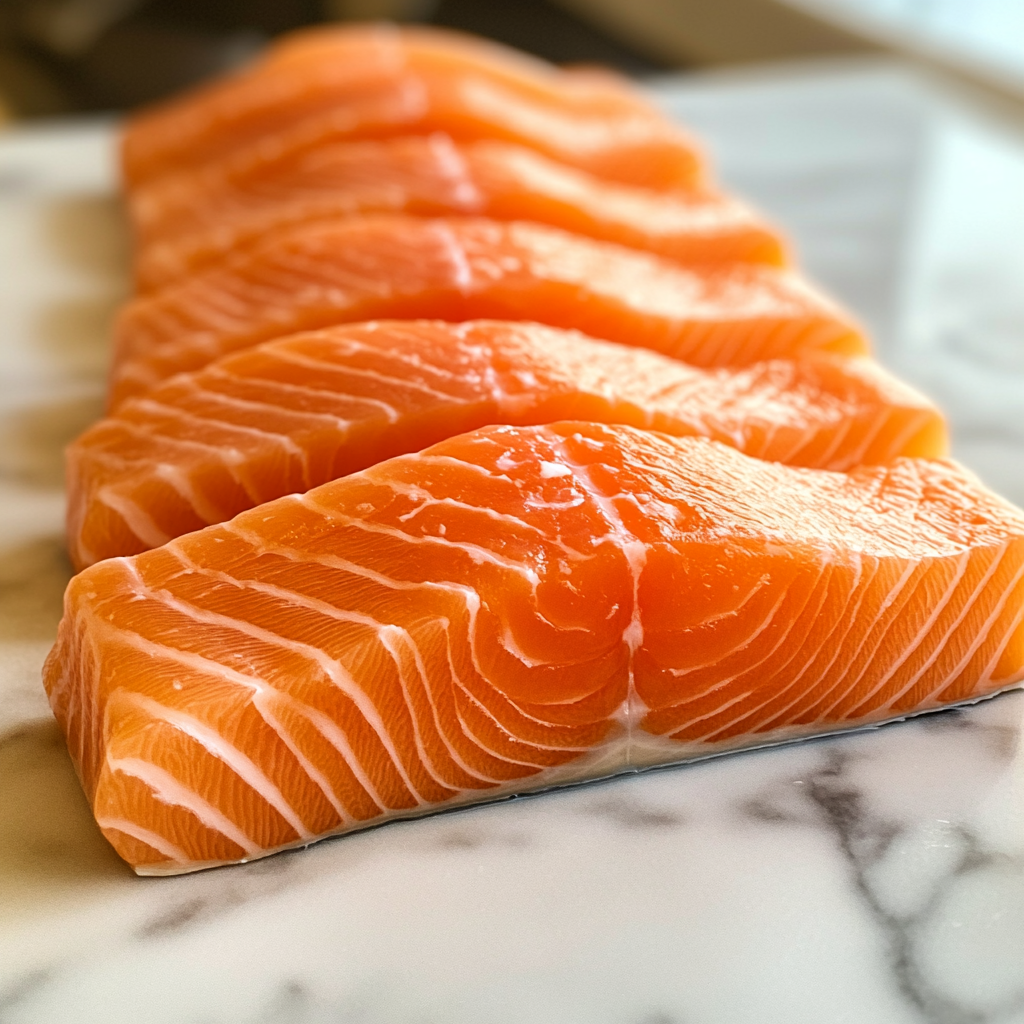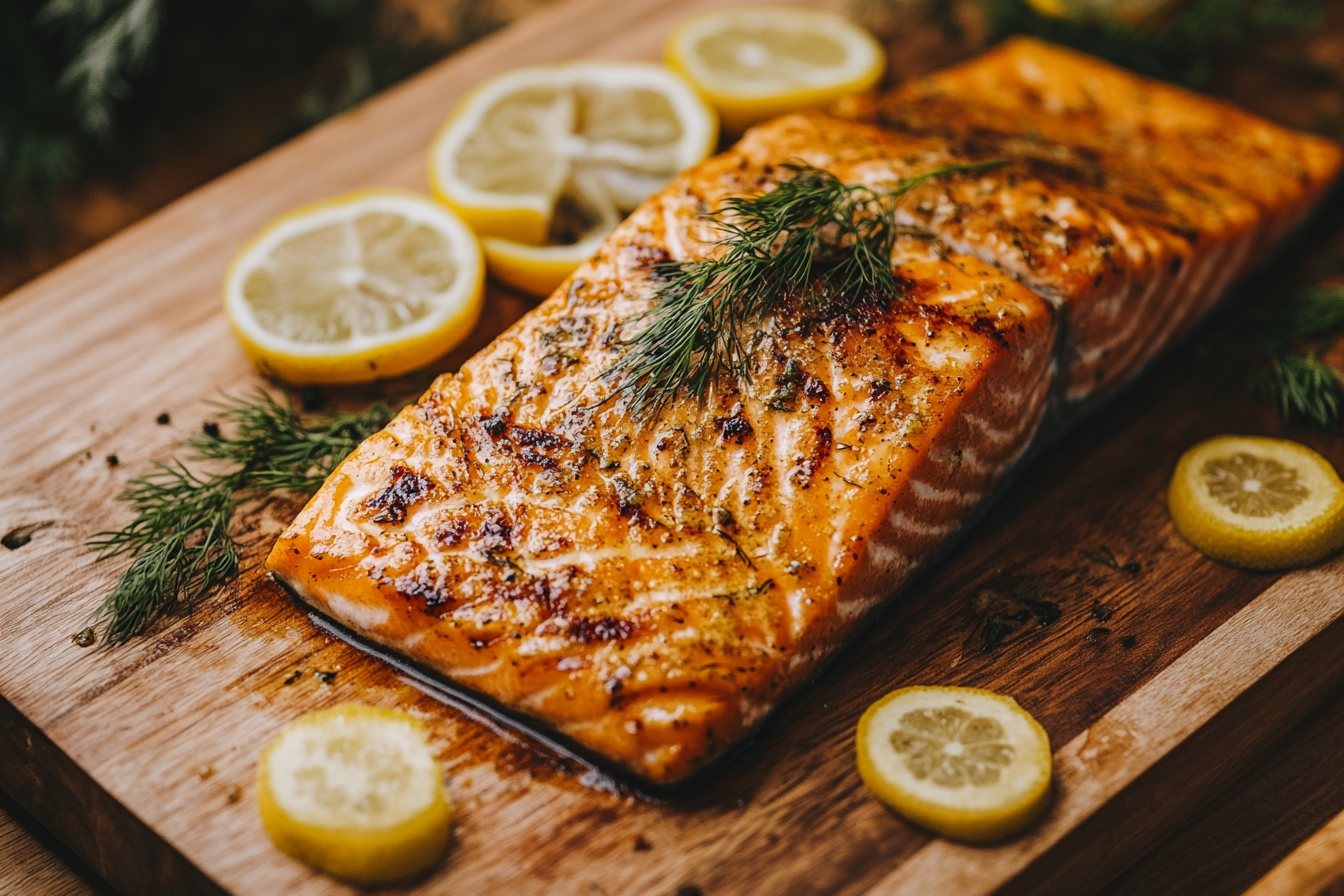Introduction
Salmon is one of the most popular fish in the culinary world, loved for its versatility, high nutritional value, and its rich flavor. Among the various species of salmon, King salmon, also known as Chinook salmon, stands out. Not only does it have a larger size, but it also carries a more luxurious, buttery taste that has earned it the title of the “king” of all salmon species.
But does King salmon taste different compared to other types of salmon like Sockeye, Coho, or Pink salmon? The answer is a resounding yes! In this article, we will dive deep into what makes King salmon’s flavor unique, how it compares to other varieties, and the best ways to cook and enjoy this prized fish.
For those ready to experience King salmon’s distinct taste, check out our King Salmon Recipe for some great ideas on how to cook this delicious fish.
What Makes King Salmon Taste Unique?
Several key factors contribute to the unique and unparalleled taste of King salmon. The most significant aspects include its fat content, diet, habitat, and texture.
Fat Content: The Key to Its Rich Flavor
One of the primary reasons King salmon tastes different from other species is its exceptionally high-fat content. This fat gives King salmon its rich, buttery texture that melts in your mouth and ensures that the fish stays moist even when cooked at high temperatures like grilling or baking.

Omega-3 fatty acids, abundant in King salmon, not only contribute to its luxurious taste but also provide substantial health benefits. These fats help improve heart health, boost brain function, and reduce inflammation. The high-fat content in King salmon ensures that it retains more moisture during cooking, leading to a tender, juicy result that other salmon species may lack. If you’re new to cooking salmon, King salmon is the ideal choice because it’s less likely to dry out due to its natural richness.
To learn more about grilling and baking King salmon to perfection, check out our Smoked Salmon Recipe Guide, which offers step-by-step tips to achieve the best results.
Diet and Habitat: Nature’s Flavor Boosters
The flavor of King salmon is heavily influenced by its natural habitat and diet. Wild King salmon inhabit the cold waters of the Pacific Ocean, where they feast on a diet rich in krill, crustaceans, and smaller fish. This diet plays a significant role in giving King salmon its delicate, yet robust, flavor. The cold waters also contribute to the development of the fish’s fat stores, further enhancing its taste.
Farmed King salmon, on the other hand, often lacks the same depth of flavor as wild-caught King salmon due to differences in diet. Farmed salmon are typically fed a controlled diet consisting of grains, which leads to a milder taste. If you’re looking to enjoy the full flavor of King salmon, wild-caught varieties are always the best choice.
For more on the differences between farmed and wild-caught salmon, be sure to explore our King Salmon Recipe to discover how sourcing affects flavor.
Color and Texture: Visual and Culinary Appeal
King salmon is renowned for its deep orange-red flesh, a result of the carotenoid pigments found in its diet, which comes from the krill and shrimp it consumes. This vibrant color signals the fish’s freshness and richness, making it a visually appealing centerpiece for any meal.
In terms of texture, King salmon is softer and more tender than other salmon species, owing to its high-fat content. While some salmon species may have a firmer bite, King salmon has a velvety, melt-in-your-mouth texture that enhances its overall eating experience. This tender texture makes King salmon the ideal choice for special occasions or when you want to elevate your seafood dishes.
For a unique pairing idea, try preparing King salmon using our Salmon Bites Recipe, which combines rich flavors with a variety of textures for an unforgettable meal.
Comparing King Salmon to Other Salmon Species
With so many varieties of salmon available, each species offers its own distinct flavor and texture profile. Let’s take a closer look at how King salmon compares to Sockeye, Coho, Pink, and Atlantic salmon in terms of taste, cooking potential, and overall experience.
Sockeye Salmon
Sockeye salmon is known for its bright red flesh and bold, robust flavor. Compared to King salmon, Sockeye has a leaner texture and a more pronounced “fishy” taste, which some seafood lovers prefer. However, its lower fat content means it can dry out quickly if overcooked. Sockeye is ideal for those who enjoy a stronger fish flavor.
- Taste: Bold, rich, and more intense than King salmon.
- Texture: Firm and lean, less moist than King salmon.
For those who enjoy Sockeye but want to explore a richer, more buttery alternative, King salmon is a great option. You can try it in our Old-Fashioned Salmon Patties Recipe for a delicious way to switch things up.
Coho Salmon
Coho salmon offers a balance between Sockeye and King salmon. It has a milder flavor than Sockeye but still retains enough richness to be satisfying. Coho has a medium-fat content, which helps it remain moist when cooked, though it doesn’t match the richness of King salmon.
- Taste: Milder than Sockeye, with a delicate flavor.
- Texture: Tender and slightly firm, though not as rich as King salmon.
If you enjoy Coho but are looking for something more luxurious, King salmon offers the same moistness with a more decadent flavor. For a refreshing and light recipe, check out our Salmon Poke Recipe, which highlights King salmon’s versatility.
Pink Salmon
Pink salmon is the most common variety used in canned salmon products. It has a light, mild flavor, making it ideal for recipes that require a less dominant fish taste. However, it doesn’t provide the depth of flavor or the rich texture that King salmon delivers.
- Taste: Light and mild, but lacks the intensity of other salmon species.
- Texture: Soft and flaky, without the richness of King salmon.
For a more flavorful option, consider upgrading to King salmon for dishes like our Salmon Rice Recipe, which makes the most of the fish’s rich flavor profile.
Atlantic Salmon
Atlantic salmon is mostly farm-raised and widely available in supermarkets year-round. While it is milder and less flavorful than wild-caught salmon, it remains a popular choice due to its affordability and availability.
- Taste: Mild and less distinct compared to wild-caught species.
- Texture: Soft and tender, but lacking the firm bite of wild-caught salmon.
For a richer, more flavorful experience, wild-caught King salmon offers a superior alternative. Consider trying it in our Salmon Rice Recipe for an easy and satisfying meal that highlights the richness of King salmon.

Cooking Methods for King Salmon
King salmon’s high-fat content makes it incredibly versatile in the kitchen. It works beautifully with various cooking methods, each one bringing out different aspects of its unique flavor and texture.
Grilling
Grilling is a popular way to cook King salmon, as the high heat caramelizes its natural oils. This creates a crispy exterior while keeping the inside moist and tender. To grill King salmon, place it skin-side down on a hot grill for 4-6 minutes per side. The skin helps protect the flesh and ensures it cooks evenly.
Pro Tip: Lightly coat the salmon with olive oil, season with salt and pepper, and serve with lemon wedges for a burst of freshness.
Baking
Baking is one of the simplest and most effective ways to cook King salmon. Preheat your oven to 375°F (190°C), place the salmon on a lined baking sheet, and bake for 12-15 minutes. This method allows the salmon to cook evenly, while the fat helps it stay moist.
Pro Tip: Add a mix of garlic, olive oil, and fresh herbs to enhance the flavor of the baked salmon. Dill, parsley, and thyme work particularly well.
Smoking
Smoking King salmon adds a rich, savory depth to the fish that highlights its natural flavors. To smoke the salmon, brine it for 6-12 hours, then place it in a smoker set at 180°F (82°C) for 2-3 hours. This method is especially popular for preparing King salmon in traditional Native American cuisine.
For those new to smoking, check out our Smoked Salmon Recipes for step-by-step guidance.

Poaching
Poaching is a gentle method that keeps King salmon moist and tender. To poach King salmon, simmer it in a broth made of wine, herbs, and spices for 10-15 minutes. This method is ideal for those who prefer a lighter, more delicate flavor.
Health Benefits of King Salmon
Not only does King salmon taste amazing, but it’s also packed with nutrients that benefit your health. It’s an excellent source of omega-3 fatty acids, which have been shown to improve heart health, reduce inflammation, and support brain function.
Omega-3 Fatty Acids
Omega-3s are essential for heart health. They help lower cholesterol levels, reduce the risk of heart disease, and improve blood pressure regulation. The high levels of omega-3s in King salmon also promote brain health and can reduce the risk of neurodegenerative diseases like Alzheimer’s.
Vitamin D and Selenium
King salmon is rich in vitamin D, which is crucial for bone health and immune function. It also contains selenium, an antioxidant that helps protect cells from damage and supports thyroid health.
For a healthy, nutrient-dense meal that highlights the health benefits of King salmon, try our Salmon Rice Recipe.
Sustainability and Sourcing
When purchasing King salmon, it’s important to consider sustainability. Wild-caught King salmon, especially from certified sustainable sources like the Marine Stewardship Council (MSC), is the best choice for those who care about the environment. These certifications ensure the salmon is harvested responsibly, protecting ecosystems and preventing overfishing.
Wild vs. Farmed King Salmon
While wild King salmon offers superior flavor, farmed King salmon can also be a viable option for those seeking more affordable or year-round choices. However, farmed salmon often has a milder flavor and fewer nutrients than wild-caught varieties.
By choosing sustainably sourced wild-caught King salmon, you’re not only enjoying the best flavor but also supporting responsible fishing practices. Explore our Old-Fashioned Salmon Patties Recipe for more ways to enjoy sustainable seafood.
Conclusion
King salmon offers a truly unique and luxurious taste experience, with its high-fat content, rich flavor, and tender texture making it stand out from other types of salmon. Whether grilled, baked, or smoked, King salmon is a versatile and delicious choice for any meal. Its numerous health benefits, including heart and brain health, make it an ideal choice for a nutrient-rich diet.
By opting for wild-caught, sustainably sourced King salmon, you can enjoy this premium fish while supporting environmentally friendly fishing practices. For more inspiration and ideas on how to prepare King salmon, check out our Smoked Salmon Recipes.

